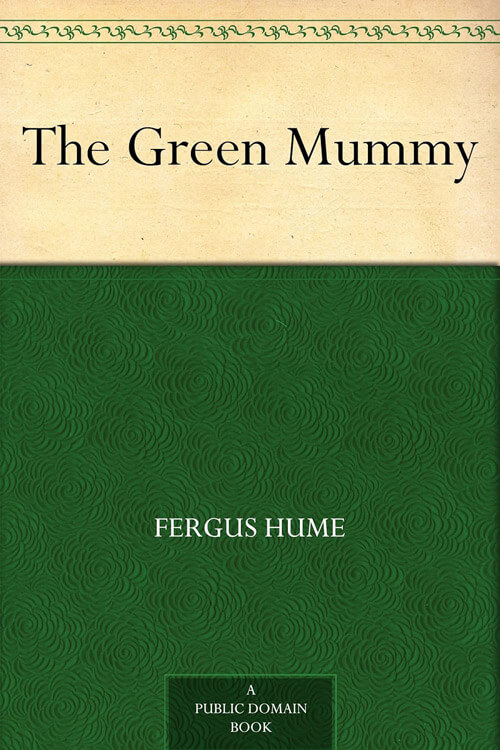
The Green Mummy
She glanced around for further illustrations in the way of contradiction.
“I can see all those things, dear, and the misplaced day also!”
“Misplaced?”
“July day slipped into September. It comes into the landscape of this autumn month, as does love into the hearts of an elderly couple who feel the supreme passion too late.”
Lucy’s eyes swept over the prospect, and the spring-like sunshine, revealing the wrinkles of ageing Nature, assisted her comprehension.
“I understand. Yet youth has its wisdom.”
“And old age is experience—the law of compensation, my dearest. But I don’t see,” he added reflectively, “what your remark and my answer have to do with the view,” whereat Lucy declared that his wits wandered.
Within the last five minutes, they had emerged from a sunken lane where the hedges were white with dust and dry with heat to a vast open space, apparently at the World. Here the saltings spread raggedly towards the stately stream of the Thames, intersected by dykes and ditches, earthen ramparts, crooked fences, sod walls, and irregular lines of stunted trees following the water courses. The marshes were shaggy with reeds and rushes and brown with coarse, fading herbage, although here and there gleamed emerald-hued patches of water-soaked soil fit for fairy rings. Beyond a moderately high barrier of turf and timber, the lovers could see the broad river, sweeping eastward to the Nore, with homeward-bound and outward-faring ships afloat on its golden tide. Across the gleaming waters, from where they lipped their banks to the foot of low domestic Kentish hills, stretched alluvial lands, sparsely timbered. In the clear sunshine, clusters of houses, great and small, factories with tall, smoky chimneys, clumps of trees and rigid railway lines could be discerned. Despite the sun’s profuse gildings, the landscape was not beautiful, but to the lovers, it appeared a Paradise.
Read or download Book
Fergus Hume
Ferguson Wright Hume (8 July 1859 – 12 July 1932), known as Fergus Hume, was a prolific English novelist, known for his detective fiction, thrillers, and mysteries.
Early life
Hume was born in Powick, Worcestershire, England, the second son of James C. Hume, a Scot and clerk and steward at the County Pauper and Lunatic Asylum there. When he was three the family emigrated to Dunedin, New Zealand, where he was educated at Otago Boys’ High School and studied law at the University of Otago. He was admitted to the New Zealand bar in 1885. Shortly after graduation, Hume relocated to Melbourne, Australia, where he obtained a job as a barrister’s clerk. He began writing plays but found it impossible to persuade the managers of Melbourne theatres to accept or even to read them.
Rise to fame
Hume first came to attention after a play he had written, entitled The Bigamist was stolen by a rogue called Calthorpe, and presented by him as his work under the title The Mormon. Finding that the novels of Émile Gaboriau were then very popular in Melbourne, Hume obtained and read a set of them and determined to write a novel of the same kind. The result was The Mystery of a Hansom Cab, set in Melbourne, with descriptions of poor urban life based on his knowledge of Little Bourke Street. It was self-published in 1886 and became a great success. Because he sold the British and American rights for 50 pounds, however, he reaped little of the potential financial benefit. It became the best-selling mystery novel of the Victorian era; in 1990 John Sutherland called it the “most sensationally popular crime and detective novel of the century”. This novel inspired Arthur Conan Doyle to write A Study in Scarlet, which introduced the fictional consulting detective Sherlock Holmes. Doyle remarked, “Hansom Cab was a slight tale, mostly sold by ‘puffing’.”
After the success of his first novel and the publication of another, Professor Brankel’s Secret (c. 1886), Hume returned to England in 1888.[3] His third novel, Madame Midas, was based on the life of the mine and newspaper owner Alice Ann Cornwell. After this book became a play[a] her estranged husband, John Whiteman, sued over its content.
Personal life
Hume settled back in England, first in London, but after a few years in Thundersley, Essex at Church Cottage, probably at the invitation of the Reverend Thomas Noon Talfourd Major. Hume lived in Thundersley for thirty years, publishing more than 130 novels, plus several collections – most of them mystery stories, though he never recaptured the success of his first novel. He also wrote lyrics to songs composed by his brother-in-law, Charles Willeby, and book reviews for literary journals including The Bookman.
The 1911 census lists him as ‘author’, aged 51, and living at Church Cottage, Thundersley, which consisted of six rooms. He had a housekeeper, Ada Louise Peck, a widow of 69. He regularly traveled to Italy, France, Switzerland, and other European countries.
When the Rev Talfourd Major died in 1915, Hume had to leave Church Cottage. He moved to ‘Rosemary Cottage’, 34 Grandview Road, Thundersley, where he lived with John Joseph Melville and his wife. Melville was a metallurgical chemist by profession, with a special study of alchemy.
Hume was reputed to be deeply religious and intensely private and known to avoid publicity, but in his later years, he lectured at young people’s clubs and debating societies. He died at Thundersley on 12 July 1932 and lies in an unmarked grave next to an actress and the Rev Maley. All he left in his will were some small items, like a horse blanket and a pipe. His estate was valued at £201.






